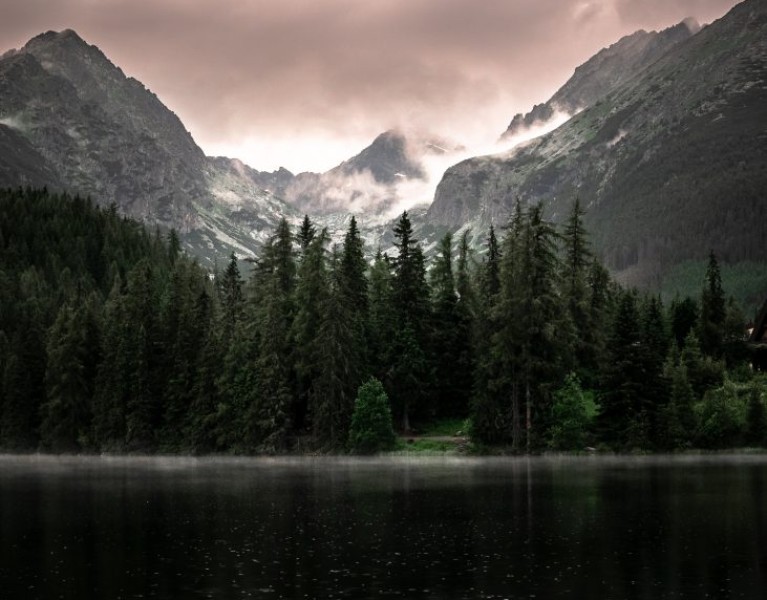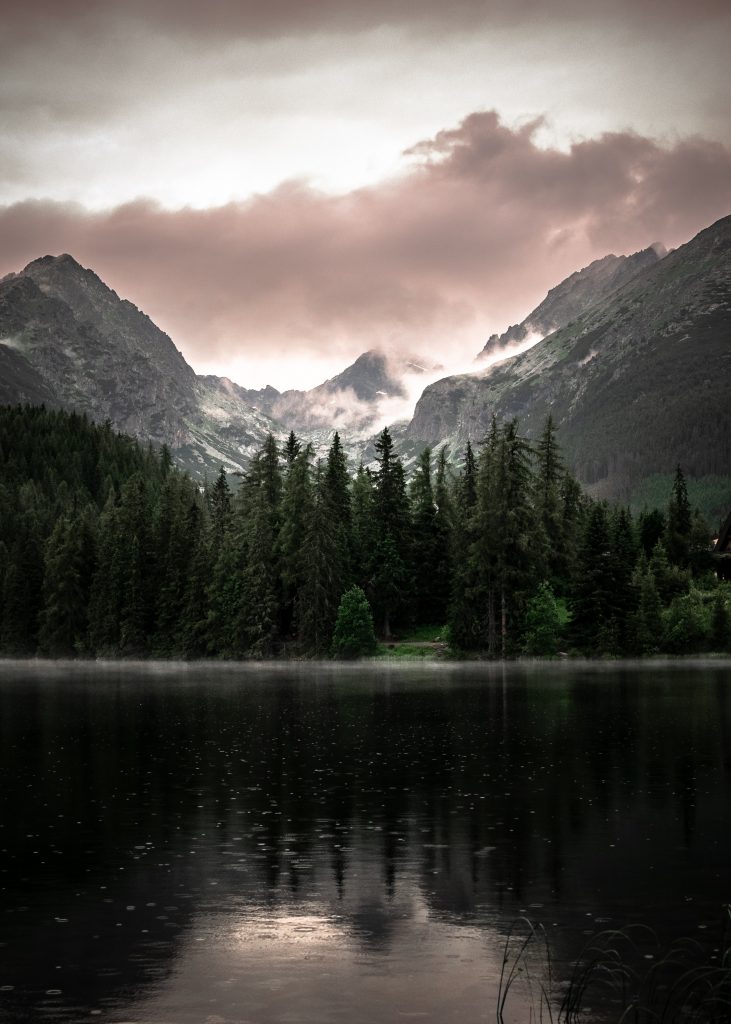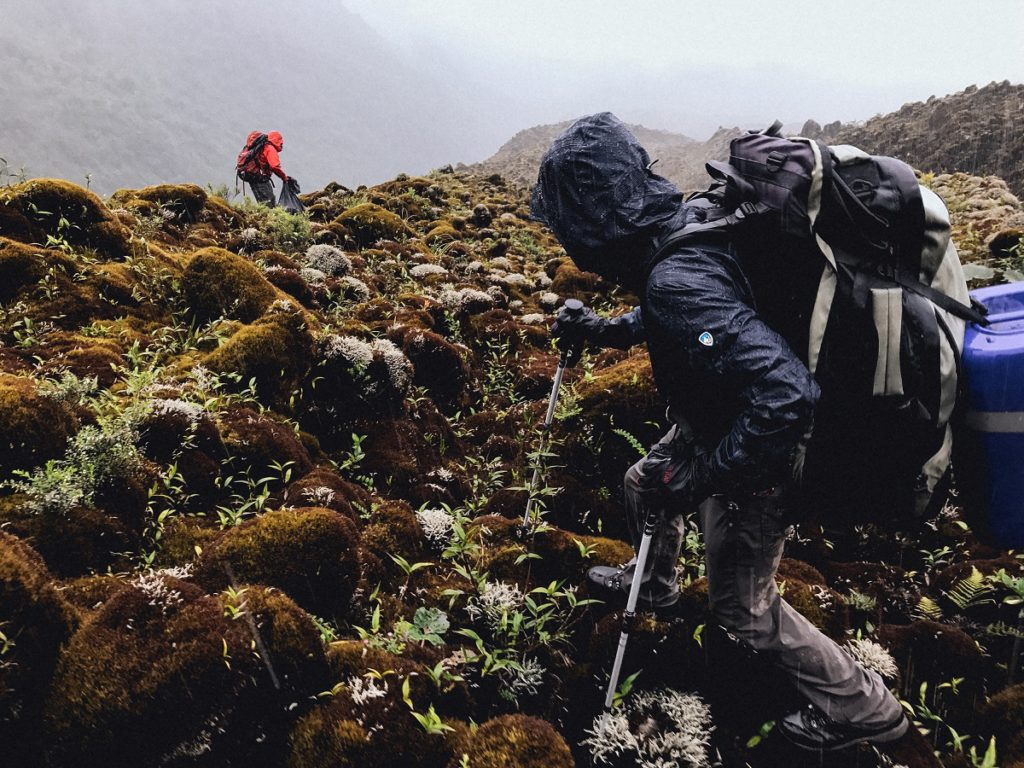- 1. Hazards of Rainy Weather
- 1.1. Flash floods
- 1.2. Hypothermia
- 1.3. Slips and falls
- 1.4. Blisters
- 2. Get the Best Gear for the Job
- 2.1. Ziploc Bag
- 2.2. Waterproofing wax
- 2.3. Waterproof Tent
- 2.4. First Aid Kit
- 3. Dress for Waterproof Protection
- 3.1. Waterproof & Breathable Pants
- 3.2. Boots with Good Grip
- 3.3. Keep your Core Warm & Dry with a Waterproof Jacket
- 3.4. Pack Extra Layers

Stay Safe & Dry When Hiking in the Rain
Table of Contents [Show]
If you've ever ventured out to the coastal redwoods of the Pacific Northwest or the stormy Atlantic coast of Maine, then you're probably acquainted with wet-weather hiking. It's soggy, drippy, and potentially uncomfortable.
It's also an incredibly unique and exciting way to experience the great outdoors, test your limits as a hiker, and build up your endurance. Rain is a nourishing part of a vibrant forest, and there's a certain beautiful tranquility to hiking in wetter climes.
However, just as dry hiking necessitates extreme care when it comes to dehydration and sun protection, hiking in wet conditions carries its own specific set of precautions. From slips to blisters, to more dangerous occurrences like flash floods or hypothermia, a little knowledge goes a long way when it comes to rainy-weather hiking and camping.
Hazards of Rainy Weather
The beauty and danger of hiking in the wild comes down to one thing: nature is a force of its own. As long as we respect that force of nature, we'll make decisions that set us up not in opposition to the elements - but working alongside them. Stay smart, stay safe, and know the dangers of wet conditions—and how to avoid serious injury.
Flash floods
The canyons in Zion National Park offer some of the most beautiful and exhilarating places to hike in the country. With the steep sandstone cliffs and remarkable views, it's a breathtaking experience. But it's not without risks.
Though it was definitely a tragic anomaly, seven hikers died in 2015 at Keyhole Canyon in Zion National Park in Utah during a flash flood. These incredible forces of nature can sweep in incredibly quickly, creating conditions unmanageable even by the most experienced hikers.
When it comes to flash floods, the key is prevention. It's okay—beautiful, even—to hike in rainy conditions, but make sure you know the area. In the case of Keyhole, this was a well-known site for dangerous flash flood conditions because it was a slot canyon, which can easily become flooded in the right conditions.
When hiking, pay attention to rangers' guidelines, the weather, and know the history of the location where you're hiking to avoid flash floods.

Hypothermia
When it comes to hypothermia, you might naturally think of Mount Everest conditions: blizzards and snow-capped cliffs. However, hypothermia can set in at conditions that are only considered merely "cool," above 40 degrees Fahrenheit, if you get drenched while hiking. Among outdoor enthusiasts like hikers, campers, and kayakers, hypothermia is the most common cause of accidental death.
Your body loses significantly more heat when wet, and this is where the danger of hypothermia sets in. So if you're hiking in cool, wet conditions, it's imperative that you wear waterproof clothing and gear. When camping, make sure that you completely change out of any wet clothing before you go to sleep.
And if you do start shivering or have a feeling of lethargy or confusion, it's important that you seek shelter and change into dry clothes immediately. Warm the body's core first, drink warm beverages, and seek help if hypothermia sets in.
Slips and falls
We're not necessarily talking about major falls off cliffs or precipices. But it does bear mentioning that in rainy weather, it's never wise to hike along a cliff face or in an area where a slip could spell a fatality instead of a just a minor inconvenience.
That said, it's important to prepare yourself for anything when venturing out in nature, so make sure you're hiking in shoes with sufficient grip. It's a way better idea to buy a new pair of hiking boots than to suffer a preventable fall due to worn grips on shoes.
If you do go out for a hike in the rain, pay attention to your surroundings. Practice vigilance, stay on prescribed trails, and avoid flash flood and cliff areas. In the occasion of a slip and fall, make sure you're well-versed in first-aid to patch up minor cuts and scrapes.
Blisters
In wet conditions, blisters constitute more than just a nuisance. The moistness can lead germs and bacteria to proliferate more quickly. And it is easier, in general, to get blisters in wet conditions because moisture creates more friction, which irritates the skin more quickly. Here's how to prevent wet-weather blisters:
- If you feel "hotspots" or areas of increased friction developing on your feet, stop hiking and check the area.
- Change into clean, dry socks whenever they become wet.
- Prevent socks from becoming wet in the first place by wearing waterproof boots and choosing a long waterproof pant that will cover the top of your boots.
- If you do get a blister, use your first aid kit to apply antibiotic ointment and cover in a clean, dry dressing.
Get the Best Gear for the Job
Ziploc Bag
It's true: the humble Ziploc bag is one of your greatest allies when hiking in rainy conditions. Even if you have a waterproof pack, we highly recommend rolling up dry clothes like socks, underwear, and shirts, and keeping them in sealed Ziploc backs inside your pack. This also goes for items like maps, cellphones, and matches. You can re-use the bag over and over again, as long as the interior stays dry.
Waterproofing wax
Waterproofing wax is an amazing product that can help protect your clothes and, more importantly, keep you warm and dry. Made of beeswax and plant-based ingredients, if you treat your clothes before venturing out, you'll create a thin layer of water-resistant wax on your materials.
Waterproof Tent
This one should be a no-brainer. Go for a waterproof when buying a tent and follow these tips:
- Choose a location at a higher elevation to avoid getting swept up during flash flood conditions.
- Set up a tarp before you begin to pitch your tent so that you're in dry conditions when you're getting the tent set up.
- Change into warm, dry clothes immediately before turning in for the night.
- There's nothing like waking up in the middle of the night to a puddle next to your sleeping bag courtesy of your dripping-wet boots. Keep your wet gear out of the tent.
First Aid Kit
This is an essential piece of gear for any hiking expedition or camping trip, but is especially important in wet conditions. Your first-aid kit will provide you with a way to patch up minor cuts and scrapes from slips and remedy blisters before they become a major issue.
Dress for Waterproof Protection
Our philosophy while hiking? It's easier to stay dry than to get dry. In order to head off the dangers of hypothermia and have a more pleasant hiking experience in general, you're going to want to emphasize waterproofed clothing.

Waterproof & Breathable Pants
Of course, we recommend long pants as opposed to shorts in rainy weather because it's important to keep your skin dry and warm. Long pants can also protect your socks from getting drenched, which is an excellent way to prevent blisters and soggy, uncomfortable wet feet.
Pants like the Jetstream™ rain pant provides a hydrophilic (water-resistant) layer but also has breathable material. Proper ventilation is key for hiking pants since wet hiking conditions also mean excess moisture in the air, which can create uncomfortable conditions.
Boots with Good Grip
It's extremely important to keep feet warm and dry while hiking in the rain, so make sure you seek out a waterproof hiking boot. There are amazing men's and women's hiking boots that are not only waterproof, but have excellent grip to decrease your chance of slipping, falling, and sustaining injuries. To prevent blisters, break in your boots before venturing out.
Keep your Core Warm & Dry with a Waterproof Jacket
While your pants and boots will keep your extremities warm and dry, it's incredibly important to prioritize your core when hiking in wet conditions to prevent hypothermia.
Whether you're looking for men's or women's down jacket styles, opt for high-quality fabrics with hydrophilic membranes that provide complete protection from the elements.
Pack Extra Layers
If you'll be hiking in areas with both wet and extremely cold conditions, make sure that you dress warm for optimal protection, and consider layering a body-temperature-regulation merino wool under a water-resistant rain jacket. Make sure you pack sufficient shirts so that you can change if you become damp or sweaty (this is where that Ziploc bag can be your best friend!)
Hiking and camping in the rain obviously present a unique set of difficulties, but it can also be incredibly rewarding. There's nothing like setting up a tent and retreating into your warm and dry oasis to hear the pitter-patter of rainfall on the top of your tent. Wet-weather hiking is an amazing way to test our limits as hikers, learn how to adapt to changes in conditions, and build up our intuition for safe hiking and camping.
All it takes is a little extra preparation to thrive in rainy hiking conditions. If you're interested in looking at waterproof hiking clothes, check out our shop. For more information and tips about hiking, check out our blog.
Featured Image by Brad Knight.


